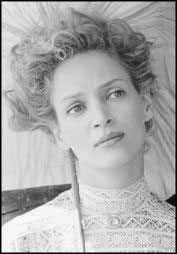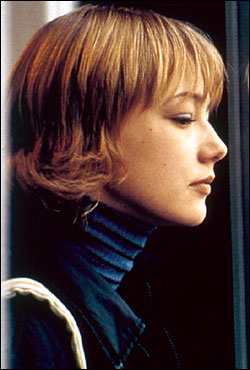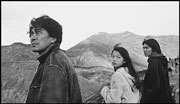The Aviator, which opens Saturday, Dec. 25, at the Metro and other theaters, is moviemaking to dream about: as big as its glamorous, deeply flawed subject, the 20th century’s pet billionaire Howard Hughes—flier, filmmaker, industrialist, aviation visionary, Olympian lover, world-class loner. It returns Martin Scorsese to the joyous, exhilarating top of his game. This time, he has a story, and a script, propulsive enough that he can flex his passions—for period detail, the ’40s, music (Lord, this picture’s music!), and bravura acting—without losing his through line (pace New York, New York; The Age of Innocence; Gangs of New York).
The Aviator‘s 20-year chunk of Hughes’ life covers his glory years: from Hollywood and Hell’s Angels in the late ’20s to the late ’40s, when he battles to make “his” airline, TWA, international. His famous phobias and the obsessive compulsiveness that will later cripple and isolate him begin here, too, like toxic wisps blowing in, then gone. As with Gladiator, John Logan’s admirable screenplay stays cleanly focused on the man at the heart of the spectacle, and Scorsese’s terrific at suggesting Hughes’ vast energies, sexual and executive, real and sublimated.
Scorsese is no stranger to sexual outrageousness as a way of defining character (remember Cape Fear‘s De Niro with young Juliette Lewis), and he gives Hughes his chance before Aviator is 10 minutes old. As “I’ll Build a Stairway to Paradise” makes the Copacabana swing, Hughes (Leonardo DiCaprio), barely 21, gets a turndown from MGM studio boss Louis B. Mayer, who won’t lend his brash, boyish competitor two cameras to finish Hell’s Angels‘ aerial dogfights. (He already has 24, but it’s a big movie.) Back at his table, Hughes, unfazed, makes a barely perceptible shift to an area where he’s supremely confident.
Scorsese fades down the background noise, so we can just make out what Hughes murmurs to a big-eyed cigarette girl in a Cleopatra headdress. He’s quiet, polite, intent; suddenly no one else in the room exists: If she’d allow it, he just wants to touch her . . . with his fingertips . . . he wants to learn what pleases her. Would she let him do that? Hughes’ experienced hands are out of the shot, but our reaction is as stunned as hers. However, with this almost Clinton-esque act, the whole audience suddenly gets Hughes’ magnetism. Hughes picks Noah Dietrich (John C. Reilly, reliability itself) to run Hughes Tool as he begins Hell’s Angels, the era’s most expensive silent film. Hughes’ fortune lets him throw months and millions into obsessive detail. If flying footage needs background clouds to give it context and oomph, they must be like “giant breasts full of milk,” uncommon in California desert skies. With the clouds finally resolved, talkies arrive, and Hughes adds another year, another million—and Jean Harlow—to reshoot with sound. (Even in a one-scene gala cameo, Gwen Stefani’s brittle Harlow is excruciating.)
For the epic aerial battle, Scorsese mixes Angels‘ breathtaking footage with Aviator cinematographer Robert Richardson’s shots for a nearly miraculous mélange. As Hughes, manning a camera himself, stands in his biplane’s open cockpit, planes dip and dive, dangerously close. When one rips off his mounted camera, Hughes grabs a handheld; then, as a plane heads straight up and over him, Scorsese throws in Bach’s hair-raising D Minor Toccata and Fugue cranked up full, until the theater shakes.
Throughout, Scorsese suggests what it must have felt like to be Hughes— congenitally deaf, preternaturally guarded. After Hell’s Angels‘ premiere (500,000 people swarming Grauman’s Chinese, stuntmen parachuting onto the roof), its success, coupled with Hughes’ money and undeniable glamour, catapults him forever into a world where flash bulbs explode in his face and crunch underfoot and banks of lights bleach out every shadow. DiCaprio registers this assault in measured amounts, until by the late 1940s, withdrawal from this insanity seems sane.
The Aviator‘s deepest moments come during Hughes’ very real love affair with Katharine Hepburn (Cate Blanchett). It’s played at first like screwball comedy, all golf dates and fizzy frankness, in cinematography that looks like hand- tinting. “Aren’t we just a fine pair of misfits?” she hoots, “I sweat and you’re deaf!” But when he pulls her out of the Copa for a night flight over Los Angeles, their worlds intersect and they become lovers. The affair reaches its greatest poignancy following Hughes’ first, relatively minor crash-landing after he breaks an air-speed record. (There will be a fireball further on that almost kills him—and us.) Tending to his bloody foot, Hepburn’s words are a rueful prophecy: “I’ve been famous a long time, and I wonder if you know what that means. . . . We have too many odd angles, too many eccentricities. We can’t let people in; they make us freaks.”
(Speaking of angles, Scorsese repeatedly cuts from sex to airplanes, from Hughes’ hands sliding along Hepburn’s smooth back to his hands stroking his plane’s streamlined silver skin, until the eroticism is blurred and it’s hard to tell which passion moves him more.)
Their breakup comes after his disastrous weekend at her family’s rock-ribbed retreat, where this much New England eccentricity drives him straight into his shell. (No wonder, it’s You Can’t Take It With You and Annie Hall combined.)
In a risky role that might’ve seemed a stunt or caricature, Blanchett doesn’t imitate, as far as one can tell—she soul-steals. The leggy stride, the golf club jauntily over her shoulder, even the “corncrick” Yankee voice are perfect, but Blanchett goes for Hepburn’s hidden sweetness, and digs it out. Amazing. The Aviator‘s biggest surprise is DiCaprio, electric and authoritative by turns, more than credible in the aviation sequences, and truly stricken in the meltdown that follows Hepburn’s leaving him for Spencer Tracy.
Hughes’ final battle brings him up against Sen. Ralph Brewster (Alan Alda, whiny and superb), so corrupt he was dubbed “the kept senator of Pan American Airlines.” By way of denying TWA international routes, Brewster plans to humiliate Hughes over the government-funded failure of his four-story wooden colossus, the Hercules (nicknamed the “Spruce Goose”), built to carry troops and equipment during World War II, but unproved at the time of the postwar hearings. We see its first (and only) attempted flight intercut with the proceedings.
Their televised exchange, which goes Hughes’ way as soon as the general laughter begins to fluster Brewster, has such a Capra-esque feeling to it that it’s startling to find it, word for word, in a Hughes biography.
Which is not to say that Aviator is the whole book on Howard Hughes. As one friend complained, “It’s like a film on Lindbergh that ends with his trans- Atlantic flight.” (A benchmark Hughes was to smash, incidentally, on the first leg of his round-the-world record, shown here in newsreel footage with DiCaprio added by computer.) The decades that followed The Aviator‘s span were ruinous, in every conceivable way, but that’s another movie and a far deeper abyss. There’s premonition enough here to throw the triumphs into bas relief, but triumphs they are, in a glorious setting.








